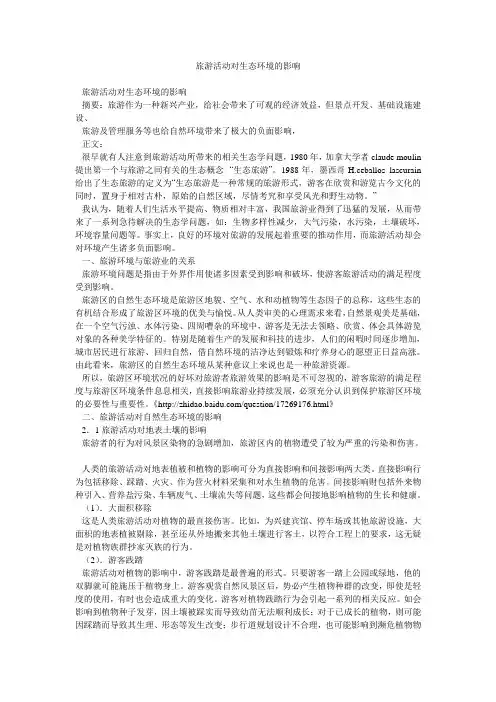生态旅游对环境的影响【外文翻译】
生态旅游对环境保护的意义

生态旅游对环境保护的意义生态旅游对环境保护的意义本文简介:[摘要]近年来,社会经济得以迅速发展,旅游行业也随之发展。
然而在环境污染越发严重的情况下,人们开始注重生态旅游,具体为在保护环境的基础上,满足人们旅游心理需求,实现人与自然和谐发展。
本文在阐述生态旅游与环境保护关系的基础上,深入分析了生态旅游的具体措施,以期实现生态旅游与环境可持续发展。
[关键词]生生态旅游对环境保护的意义本文内容:[摘要]近年来,社会经济得以迅速发展,旅游行业也随之发展。
然而在环境污染越发严重的情况下,人们开始注重生态旅游,具体为在保护环境的基础上,满足人们旅游心理需求,实现人与自然和谐发展。
本文在阐述生态旅游与环境保护关系的基础上,深入分析了生态旅游的具体措施,以期实现生态旅游与环境可持续发展。
[关键词]生态旅游;环境保护;关系;具体措施所谓生态旅游,主要是指通过创造良好的生态自然环境,获取旅游经济效益,并且通过该收益用于区域环境建设,切实提升生态环境质量,以此促进经济与环境的可持续发展。
生态旅游作为可持续发展战略中的重要环节,已然受到了大众的高度重视。
根据有效调查数据显示,生态旅游市场份额高达整个旅游市场的30%。
我国生态旅游事业处于起步阶段,在生态旅游事业的迅速发展的同时,生态环境遭到严重破坏,与生态旅游的终极目标可持续发展相违背。
因此,我国要想实现生态旅游可持续发展,则需要切实处理好生态旅游与环境保护的关系。
鉴于此,本文对“生态旅游和环境保护的关系”进行更深层次的分析具有极为重要的现实意义。
1生态旅游与环境保护的关系概述生态旅游与环境保护之间具有一层复杂的关系,究其原因在于生态旅游对环境保护具有积极影响,同样存在消极影响。
为此实现可持续发展,则需要处理好两者之间的关系。
接下来,对其加以具体分析。
1.1环境质量决定着生态旅游价值大自然是一个神奇的地方,有着秀色可餐的山川、风景秀丽的田园等,均是美好环境中的一部分。
人们通过浏览大自然,能够满足自身的精神需求。
生态旅游与环境保护的关系及影响

生态旅游与环境保护的关系及影响随着全球环保意识的不断提高,生态旅游也逐渐成为旅游业的一大热门。
生态旅游是指在自然环境中进行的旅游活动,例如探险、观赏、生态保护和环境教育等。
生态旅游的发展有助于保护生态环境,但同时也需要注意生态旅游对环境的影响。
本文将浅谈生态旅游与环境保护的关系及影响。
一、生态旅游的意义生态旅游被认为是旅游业的可持续发展方向,因为它有以下几个方面的意义。
1. 保护生态环境生态旅游一般发生在更为自然的环境中,例如山区、海滩和河流等。
这些地方通常是生态环境比较纯净的地方。
生态旅游活动的开展,一方面能够保护自然环境,另一方面也可以让游客更好地了解自然环境,从而进一步树立环保意识。
2. 促进经济和社会发展生态旅游活动能够为当地带来更多的旅游收入,同时也可以促进当地经济和社会发展。
例如,生态旅游在许多发展中国家是旅游业的一大支柱经济。
通过旅游业的发展,当地也能够提高生活水平和改善人民生活。
3. 改善旅游环境生态旅游活动通常需要保持现场的整洁和有序,这有助于维护环境的整洁。
此外,生态旅游活动的开展有时也需要在环境上进行改造和修复,这也能够改善旅游环境。
二、生态旅游对环境保护的影响生态旅游对环境保护的影响主要有以下几个方面。
1. 带来旅游压力生态旅游的流行有时会带来旅游压力,也就是说,大量游客可能会对当地自然环境造成负面影响。
例如,大量游客进入一个地区可能会在短时间内对这个地区造成环境破坏,例如污染、砍伐植被或捕捞等。
2. 增加垃圾量在现代文明社会中,旅游活动必然会产生各种垃圾,包括橡皮制品、泡沫杯、纸巾等,这些垃圾都会对环境造成污染。
虽然国家和地方的相关法规要求旅游经营者担负起垃圾处理的责任,但现实情况并不完善,部分旅游从业者的垃圾处理行为不规范。
3. 损坏文化遗产在一些生态旅游重点区域,有很多文化遗产,例如古建筑、城墙、壁画、陵墓和寺庙等。
在旅游高峰期间,大量游客可能会对文化遗产造成损坏,例如涂鸦、撕毁或刻画等,这会严重破坏文化遗产的完整性和保护价值。
生态旅游发展对生态环境的影响研究

生态旅游发展对生态环境的影响研究随着人们对旅游的需求越来越高,生态旅游作为一种更加注重环境保护和可持续发展的形式逐渐流行起来。
生态旅游不仅能够让游客感受到大自然的美好,还能够促进当地经济发展,但是在发展生态旅游的同时,也会对生态环境带来一定的影响。
一、生态旅游对自然环境的影响在推广生态旅游的过程中,自然环境是最重要的资源。
因此,为了保留生态旅游的基础,自然环境必须得到保护。
然而,生态旅游的发展也会对自然环境造成一定影响。
旅游者的涌入和旅游活动的开展,无论是在地面还是在水面上,都会对当地的生态环境产生一定的压力。
例如,在海滨旅游区,沙滩上的行人、戏水、垃圾等都会对海滩生态环境造成不同程度的影响。
此外,为了开发生态旅游,有可能会需要建造一些基础设施,如道路、酒店、休闲设施等,这也会对自然环境带来一定负面的影响。
建筑物的建设需要消耗大量的资源和能源,同时也会破坏当地的自然景观,例如,在山区开发生态旅游,就会对山体生态环境产生破坏。
二、生态旅游对社会环境的影响生态旅游的发展一方面能够促进当地经济发展,提高地方居民的生活水平,推动社会和谐。
另一方面,它也会对社会环境产生影响。
生态旅游的发展带来了人群的流动。
特别是一些漂泊旅游者的出现,也增加了当地社会的不确定性。
带来的负面影响主要集中在:1.对居民生活的影响生态旅游的快速发展和旅游者的增多会对当地居民的生活造成一定的影响。
例如,旅游高峰期节假日,在酒店和餐厅的人流量大幅度增加,光是酒店的足球场就可以容纳很多人。
2.对当地文化遗产的影响生态旅游对当地文化遗产的保护和传承起着重要作用,这一方面还需要持续的研究和保护。
但是在一些热门旅游景点,为了满足旅游者需求,很多当地特色餐饮和文化产业却被抛弃。
三、如何有效应对生态旅游所带来的环境影响生态旅游发展是综合性的、持续性的生态旅游,必须建立在合理、科学的规划计划和严格的管理制度的基础上。
它不能只是简单地发展,还需要考虑生态环境的保护和可持续性的发展1.加强规划、监管和标准制定政府和相关部门应当加强规划、监管和标准制定,以确保生态旅游的发展在保护自然生态环境的同时,保持其可持续性。
生态旅游发展对环境有什么影响

生态旅游发展对环境有什么影响生态旅游作为一种新兴的旅游方式,在近年来得到了快速的发展。
它强调在保护自然环境和文化遗产的基础上,让游客获得独特的旅游体验。
然而,生态旅游的发展并非完全没有负面影响,它对环境的影响是多方面的,需要我们进行全面而深入的探讨。
生态旅游的积极影响是显而易见的。
首先,它有助于保护自然生态系统。
通过将旅游活动与环境保护相结合,生态旅游为野生动植物的栖息地提供了一定的保护和资金支持。
例如,一些自然保护区开展生态旅游项目,所得收入可以用于改善保护区的设施、加强巡逻和监测,从而更好地保护区内的珍稀物种和生态平衡。
其次,生态旅游能够促进当地社区的经济发展和居民生活水平的提高。
在一些偏远地区,生态旅游为当地居民提供了就业机会,如导游、手工艺制作、民宿经营等,增加了他们的收入来源。
这使得当地居民更加重视环境保护,因为良好的环境是吸引游客、维持生计的关键。
再者,生态旅游有助于提高公众的环保意识。
游客在参与生态旅游的过程中,能够亲身感受大自然的美丽和脆弱,了解生态系统的运作和生物多样性的重要性。
这种亲身体验往往能够激发游客在日常生活中采取更加环保的行动,从而产生更广泛的社会影响。
然而,生态旅游的发展也给环境带来了一些挑战和问题。
过度开发是一个突出的问题。
一些地方为了吸引更多的游客,过度建设旅游设施,如道路、酒店、娱乐设施等,这可能导致土地的不合理利用和生态破坏。
例如,在山区修建过多的道路和缆车,可能破坏山体结构,引发水土流失和地质灾害。
游客数量的增加也可能对生态环境造成压力。
大量游客的涌入可能超出了生态系统的承载能力,导致资源的过度消耗和环境的污染。
比如,在一些热门的生态旅游景点,游客产生的垃圾可能无法及时清理,对土壤、水源和空气造成污染;游客的活动可能干扰野生动物的正常生活,影响它们的觅食、繁殖和迁徙。
此外,生态旅游的管理不善也可能带来负面影响。
如果缺乏有效的规划和监管,旅游活动可能会违反环保规定,如非法狩猎、采集野生植物等。
旅游活动对生态环境的影响

旅游活动对生态环境的影响旅游活动对生态环境的影响摘要:旅游作为一种新兴产业,给社会带来了可观的经济效益,但景点开发、基础设施建设、旅游及管理服务等也给自然环境带来了极大的负面影响,正文:很早就有人注意到旅游活动所带来的相关生态学问题,1980年,加拿大学者claude moulin 提出第一个与旅游之间有关的生态概念--“生态旅游”。
1988年,墨西哥H.ceballos lascurain 给出了生态旅游的定义为“生态旅游是一种常规的旅游形式,游客在欣赏和游览古今文化的同时,置身于相对古朴,原始的自然区域,尽情考究和享受风光和野生动物。
”我认为,随着人们生活水平提高、物质相对丰富,我国旅游业得到了迅猛的发展,从而带来了一系列急待解决的生态学问题,如:生物多样性减少,大气污染,水污染,土壤破坏,环境容量问题等。
事实上,良好的环境对旅游的发展起着重要的推动作用,而旅游活动却会对环境产生诸多负面影响。
一、旅游环境与旅游业的关系旅游环境问题是指由于外界作用使诸多因素受到影响和破坏,使游客旅游活动的满足程度受到影响。
旅游区的自然生态环境是旅游区地貌、空气、水和动植物等生态因子的总称,这些生态的有机结合形成了旅游区环境的优美与愉悦。
从人类审美的心理需求来看,自然景观美是基础,在一个空气污浊、水体污染、四周嘈杂的环境中,游客是无法去领略、欣赏、体会具体游览对象的各种美学特征的。
特别是随着生产的发展和科技的进步,人们的闲暇时间逐步增加,城市居民进行旅游、回归自然,借自然环境的洁净达到锻炼和疗养身心的愿望正日益高涨。
由此看来,旅游区的自然生态环境从某种意议上来说也是一种旅游资源。
所以,旅游区环境状况的好坏对旅游者旅游效果的影响是不可忽视的,游客旅游的满足程度与旅游区环境条件息息相关,直接影响旅游业持续发展,必须充分认识到保护旅游区环境的必要性与重要性。
《/question/17269176.html》二、旅游活动对自然生态环境的影响2.1旅游活动对地表土壤的影响旅游者的行为对风景区染物的急剧增加,旅游区内的植物遭受了较为严重的污染和伤害。
生态旅游对保护自然环境的影响评估

生态旅游对保护自然环境的影响评估生态旅游被认为是一种与环境保护相协调的旅游形式,通过提供与自然环境的接触和体验,旨在促进自然资源的保护和可持续利用。
然而,生态旅游实际上对保护自然环境产生了复杂的影响。
本文将评估生态旅游对保护自然环境的影响。
一、经济发展与生态旅游随着经济的发展,生态旅游已成为各国重要的经济产业。
生态旅游的发展不仅使得自然资源得到合理的利用,还为保护自然环境提供了经济支持。
举例来说,一些生态旅游景区的发展引入了新的就业机会,增加了居民的收入,从而提高了当地居民的环境保护意识,并推动了对自然资源的保护和可持续利用。
二、生态旅游与生物多样性生态旅游对保护生物多样性起到了积极的影响。
生态旅游的旅游者往往对自然环境有着较高的敬畏和欣赏之情,他们愿意参与并支持当地的生物多样性保护项目。
通过生态旅游活动,人们能够亲身体验到野生动植物的美丽与珍稀,从而增强对生物多样性保护的意识。
同时,生态旅游还对保护自然栖息地起到了一定的推动作用,通过规划和管理生态旅游区,可以减少人类活动对栖息地的破坏,为野生动植物提供更好的生存环境。
三、旅游压力与环境破坏然而,生态旅游也面临着一些挑战。
旅游活动的增加可能对自然环境造成过度的压力,导致环境破坏事态的恶化。
过度的游客数量和不负责任的旅游行为可能破坏当地的生态系统,破坏了生物多样性,甚至导致了生物栖息地的破坏和生态系统的崩溃。
因此,管理和限制旅游活动的规模和行为对于保护自然环境至关重要。
四、生态旅游与当地社区生态旅游的目标之一是促进当地社区的发展和改善。
通过生态旅游,游客能够认识到当地社区的独特魅力和文化,从而增加对当地社区的支持和关注。
生态旅游可以带动当地社区的经济发展,提高居民的生活水平,从而降低了他们对自然资源的不合理开发的需求。
同时,生态旅游还可以促进当地居民对环境保护的意识,培养他们的环境友好行为和方式。
五、可持续发展与生态旅游生态旅游的可持续发展是保护自然环境的关键。
旅游业对环境的负面影响英语作文
旅游业对环境的负面影响英语作文英文回答:Negative Impacts of Tourism on the Environment.Tourism, a significant contributor to global economies, often carries a heavy environmental burden. While it can bring economic benefits to local communities, it can also have detrimental effects on fragile ecosystems and natural resources. Here are some of the key negative impacts of tourism on the environment:1. Depletion and Pollution of Water Resources:Mass tourism puts a strain on local water resources. Tourists consume large amounts of water for bathing, swimming, and other activities. This can lead to depletion of water sources, especially in arid regions. Additionally, wastewater from hotels, restaurants, and other tourist facilities can contaminate water bodies, harming aquaticecosystems.2. Air Pollution:Tourism contributes to air pollution through transportation and other activities. Aircraft emissions, car rentals, and tour buses release harmful pollutants into the atmosphere. Cruise ships also emit significant amounts of air pollutants, including sulfur dioxide and nitrogen oxides. These emissions can contribute to respiratory problems, climate change, and damage to ecosystems.3. Deforestation and Habitat Destruction:To accommodate tourist facilities such as hotels, resorts, and golf courses, natural habitats are often cleared and deforested. This results in the loss of biodiversity, disruption of ecosystems, and soil erosion. Deforestation can also contribute to climate change by reducing carbon sinks.4. Waste Generation:Tourism generates large amounts of solid waste, including plastics, food scraps, and packaging. In many popular tourist destinations, waste management systems are overwhelmed, leading to accumulation of waste in landfills, beaches, and other areas. This waste can pollute water bodies, harm wildlife, and detract from the aesthetic beauty of natural environments.5. Damage to Marine Ecosystems:Coastal tourism can have significant impacts on marine ecosystems. Activities such as snorkeling, diving, and boating can damage coral reefs and marine life. Overfishing and the use of unsustainable fishing practices can further deplete fish populations and disrupt the balance of marine ecosystems.6. Overcrowding and Degradation of Natural Sites:Mass tourism can lead to overcrowding and degradation of popular natural sites. Large numbers of tourists cantrample vegetation, disturb wildlife, and contribute to erosion. This can damage the very resources that tourists come to experience, reducing their value and attractiveness.7. Cultural Impacts:In some cases, tourism can have negative cultural impacts. The presence of large numbers of tourists can disrupt local traditions and lifestyles. Commercializationof cultural heritage can lead to the loss of authenticity and the erosion of cultural identity.Mitigating the Negative Impacts of Tourism:Recognizing the environmental challenges posed by tourism, it is essential to implement measures to mitigate its negative impacts. Strategies include:Promoting sustainable tourism practices.Encouraging responsible behavior among tourists.Investing in waste management and water conservation systems.Limiting development in sensitive areas.Regulating tourism activities to protect ecosystems.Raising awareness about the environmental risks associated with tourism.By embracing these measures, we can help to reduce the environmental impact of tourism and preserve our natural and cultural heritage for future generations.中文回答:旅游业对环境的负面影响。
生态旅游的环境影响与管理策略
生态旅游的环境影响与管理策略一、引言生态旅游是近年来备受关注的旅游方式,其强调在自然环境中接触、观赏和学习,并且注重对当地文化与环境的保护。
然而,随着生态旅游的兴起,也带来了一些环境问题。
本文将就生态旅游对环境的影响及管理策略展开探讨。
二、生态旅游对环境的影响1. 生态旅游的益处生态旅游能够促进地方经济的发展,增加当地居民的收入。
同时,它也能提高人们对环境保护的意识,促进当地生态环境的改善。
生态旅游还有助于传承和保护当地文化遗产,促进文化多样性的发展。
2. 生态旅游对环境的负面影响然而,随着生态旅游的发展,也带来了一些环境问题。
大量游客的涌入可能会对原有生态系统造成破坏,破坏当地的植被和动物栖息地。
游客可能会产生废弃物、污染水源,对当地水土资源造成影响。
同时,过度开发生态旅游资源也有可能加剧生态环境的脆弱性,进一步加剧环境问题。
3. 典型案例分析以某生态景区为例,随着生态旅游的发展,景区内游客数量激增,其中的垃圾堆积、水源污染、植被破坏等问题愈发突出,给当地生态环境造成严重影响。
三、生态旅游环境管理策略1. 加强相关部门管理相关部门部门应该出台相应法规和,加强对生态旅游业的监管,确保生态旅游的可持续发展。
同时,相关部门还应该积极开展环境保护宣传教育工作,提高游客对环境保护的认识。
2. 推行低碳生态旅游鼓励生态旅游企业采用低碳出行方式,提倡步行、骑行等环保出行方式。
减少游客对环境的破坏,降低碳排放量,保护当地生态环境。
3. 强化环保设施建设加大对生态旅游区环保设施的建设投入,完善排污处理设施、垃圾处理设施等,保障当地环境的洁净。
并且要确保这些设施的正常运行与维护,以应对生态旅游带来的环境影响。
4. 提倡可持续发展生态旅游要本着可持续发展的理念,避免过度开发生态资源,确保其在不破坏生态平衡的前提下持续发展。
倡导游客尊重当地文化、生态环境,保持环境友好的行为。
四、结论生态旅游作为一种环保意识强烈的旅游方式,尽管在诸多方面给当地环境带来了一定负面影响,但通过相关部门、企业和游客各方合力的管理与合作,可以有效减少这些负面影响,促进环境保护与经济发展的平衡。
生态旅游给环境带来的影响如何
生态旅游给环境带来的影响如何在当今社会,随着人们生活水平的提高和环保意识的增强,生态旅游作为一种新兴的旅游方式正逐渐受到青睐。
人们渴望亲近大自然,感受其神奇与美丽,同时也希望通过这种方式促进对生态环境的保护和可持续利用。
然而,生态旅游并非只有积极的一面,它也给环境带来了一系列复杂的影响。
生态旅游的发展在一定程度上对环境起到了保护作用。
当一个地区被开发为生态旅游区时,当地政府和相关机构通常会加大对该区域生态环境的保护力度。
为了吸引游客,会投入资金进行生态修复、植树造林、治理水土流失等工作,使得原本受损的生态系统得到一定程度的恢复和改善。
而且,生态旅游能够增强公众的环保意识。
游客在参与生态旅游的过程中,通过导游的讲解、宣传资料的介绍以及亲身体验,更加深入地了解到生态环境的重要性和脆弱性。
这种教育和启发能够促使游客在日常生活中更加注重环保,形成良好的环保习惯和行为。
然而,我们也不能忽视生态旅游给环境带来的负面冲击。
首先是游客数量的增加给生态系统带来了巨大压力。
过多的游客涌入,可能会超过生态环境的承载能力。
比如,在一些自然保护区,游客的频繁践踏会破坏地表植被,影响土壤结构,导致水土流失加剧。
生态旅游中的基础设施建设也可能对环境造成破坏。
为了满足游客的需求,需要修建道路、停车场、住宿设施等。
这些建设活动可能会破坏原有的地形地貌,干扰野生动物的栖息地,甚至导致一些珍稀物种的生存受到威胁。
再者,旅游活动产生的废弃物也是一个严重的问题。
游客在游玩过程中产生的大量垃圾,如果处理不当,会污染土壤、水源和空气。
特别是在一些偏远的生态旅游区,垃圾收集和处理设施不完善,废弃物往往被随意丢弃,给环境造成了长期的污染。
此外,生态旅游中的不文明行为也时有发生。
有些游客为了追求刺激或者出于好奇,违反规定采摘珍稀植物、骚扰野生动物,这些行为都会对生态平衡造成破坏。
为了减少生态旅游对环境的不利影响,实现可持续发展,我们需要采取一系列措施。
旅游业的发展对环境造成的危害英文作文
旅游业的发展对环境造成的危害英文作文全文共6篇示例,供读者参考篇1The Impacts of Tourism on Our PlanetHi there, friends! Today, I want to talk to you about something really important – how the tourism industry can affect our beautiful Earth. You see, while traveling and exploring new places is a lot of fun, it can also cause some problems for the environment if we're not careful.First, let's talk about one of the biggest issues –transportation. When people travel, they often use planes, cars, buses, or trains to get to their destinations. All of these vehicles release harmful gases called "carbon emissions" into the air. These gases contribute to something called "climate change," which is causing the Earth's temperature to rise and leading to problems like melting ice caps and more extreme weather.Another problem caused by tourism is the production of waste. Think about all the trash that can be generated when lots of people visit a place – things like plastic bottles, food packaging, and other garbage. If this waste isn't properlydisposed of or recycled, it can end up polluting the environment, harming animals, and making natural areas look really messy.Then there's the issue of overcrowding. When too many tourists visit a place at the same time, it can put a lot of strain on the local environment. Imagine if thousands of people were all trying to visit a beautiful beach or a fragile ecosystem like a coral reef – it could cause serious damage!But it's not all bad news! There are ways that the tourism industry can become more environmentally friendly. For example, hotels and resorts can use energy-efficient lighting and appliances, recycle their waste, and encourage guests to conserve water. Tour operators can offer eco-friendly activities like hiking, kayaking, or birdwatching, which have a lower impact on the environment.Governments and organizations can also help by setting up protected areas, like national parks and nature reserves, where the wildlife and natural habitats are carefully managed and preserved. They can also educate tourists about how to be more responsible and respectful when visiting these special places.As individuals, we can all do our part too! When we travel, we can choose to stay in eco-friendly accommodations, use public transportation or walk whenever possible, and be mindfulof our waste. We can also support businesses and tour operators that prioritize sustainability and environmental protection.Remember, our planet is an amazing place, filled with incredible natural wonders and diverse ecosystems. It's up to all of us to take care of it, so that future generations can continue to enjoy and explore its beauty. By being responsible travelers and supporting sustainable tourism practices, we can ensure that our adventures don't come at the cost of damaging the environment.So, the next time you plan a trip, think about how you can make it a little greener. It's a small step, but if we all do our part, we can make a big difference in protecting our one and only Earth!篇2The Harmful Effects of Tourism on the EnvironmentTourism is a popular activity that many people enjoy. Going on vacation to new and exciting places can be a lot of fun. You get to see amazing sights, try delicious new foods, and make lots of wonderful memories. However, the tourism industry can also cause serious damage to the environment if it's not managedcarefully. Let me tell you about some of the harmful effects that tourism has on nature and our planet.One major issue is transportation. In order to get to their vacation destinations, many tourists travel long distances by airplane, cruise ship, car, bus or train. All of these modes of transportation produce greenhouse gas emissions like carbon dioxide that contribute to climate change and global warming. Airplanes are especially bad, releasing tons of carbon dioxide high up in the atmosphere where it traps a lot of heat. The more people travel for tourism, the more greenhouse gases get pumped into the air. This pollution is really harmful for the environment.Another big problem caused by tourism is an increase in solid waste and litter. Popular tourist destinations often struggle with how to dispose of the excessive amounts of trash generated by visitors. Plastic waste like bottles, bags, and food packaging is a particular issue, since most types of plastic are not biodegradable. This litter can end up on beaches, in oceans, or strewn across the beautiful natural landscapes that tourists came to enjoy in the first place. It's very sad to see such gorgeous places being treated like garbage dumps.The construction of hotels, resorts, theme parks, restaurants, airports and other tourist facilities can also severely damage local ecosystems. Often these developments involve tearing down forests, filling in wetlands, dredging coastal areas, or paving over habitats that were homes to many species of plants and animals. The loss of biodiversity is a major consequence of uncontrolled tourism development in ecologically sensitive areas. It's heartbreaking when endangered and threatened species lose their homes so that humans can build more hotels or golf courses.Water pollution is another big concern related to tourism. Resorts, cruise ships, and other places that cater to tourists often dump their sewage and wastewater directly into the ocean with minimal or no treatment. This effluent contains nutrients like nitrogen and phosphorus that can cause algal blooms and dead zones in coastal waters. It also contains bacteria, viruses, oils, and chemicals that contaminate marine ecosystems. No one wants to go swimming in gross, polluted water on their vacation!In addition, tourism frequently damages ancient ruins, archaeological sites, and culturally significant locations through overvisitation, vandalism, and removal of artifacts by tourists. These irreplaceable pieces of human heritage should bepreserved and protected, not destroyed by large crowds of disrespectful tourists trampling all over them and defacing them with graffiti or theft.So as you can see, as fun as tourism might seem, it can actually have really negative impacts on the environment in a lot of different ways if it's not done responsibly and sustainably. We need to find better solutions for reducing the carbon footprint of travel, managing waste properly, preserving ecosystems and endangered species, preventing water pollution near tourist areas, and protecting cultural heritage sites. Otherwise, the beautiful natural areas and historic sites that attract tourists could eventually become damaged beyond repair. We should aim to promote more eco-friendly and culturally-sensitive tourism practices so that people can still enjoy traveling while also taking care of our precious planet Earth.篇3The Growth of Tourism and Its Impact on NatureHi there! My name is Emma and I'm a 4th grader. Today I want to talk to you about something that's really important –how the booming tourism industry is harming our beautiful planet.You see, more and more people are traveling to cool places like beaches, mountains, and big cities for vacations and fun adventures. While it's awesome to explore new places, all those tourists are making a pretty big mess that's bad for the environment.Let me give you some examples of how tourism hurts nature:Damage to Ecosystems and Animal HabitatsWhen too many tourists visit a place, it can really disrupt the local ecosystems. They trample on plants, leave trash everywhere, and make lots of noise that scares away animals. Their activities like off-road driving, hiking off trails, and taking rocks or plants as souvenirs destroys the habitats that wildlife needs to survive.In places like the Galapagos Islands, the super cool giant tortoises and other amazing animals are losing their homes due to too many tourists. Poorly managed tourist sites have led to soil getting eroded, water sources being polluted, and animals being harassed by people trying to get close for pictures or feed them.Increased Pollution and WasteAnother huge problem is all the pollution and trash created by tourists. You've got emissions from planes, trains, and tourbuses. Then there are hotels and resorts using up tons of water and energy. Not to mention all the plastic bottles, food wrappers, and other litter left behind at beaches, parks, and tourist sites.In places like Venice, Italy, the stunning canals are getting polluted by cruise ships dumping waste and fuel into the water. On tropical islands, you have way more trash than can be properly disposed of piling up everywhere. Gross!Destruction of Natural LandscapesAs tourism grows in natural areas, you see a lot of construction and development that forever changes and even destroys landscapes. Developers build huge resorts right on beachfronts, cutting down forests and filling in coastal wetlands. Mountain areas get ski resorts with cleared trails. Hiking paths get paved over.In places like Hawaii, rampant coastal development for fancy resorts and golf courses has led to beaches eroding away and damage to coral reefs. The once pristine natural beauty gets completely covered up by concrete and construction.Overuse of ResourcesAnother big issue is the strain tourism puts on natural resources like water, energy, food and more in destination areas.All those hotels, swimming pools, restaurants, and tourist facilities use up way more water and electricity than the local area was prepared for. Food, beverages and other supplies have to be brought in from far away.Take a small beach town for example - the resources were meant for a small local population. But during peak tourist season, you have an overwhelming influx of visitors all taking showers, drinking water, using air conditioning and lots of electricity. It can quickly lead to water shortages, energy crises, and disruptions to the local food supply.Cultural DegradationLastly, I want to mention how tourism can negatively impact local communities and cultures. An overwhelming surge of foreign tourists and influences often drowns out the traditional cultures of an area. Local people may change their way of life, dress and values to cater to tourists. Sacred sites get overrun and disrespected.You see this a lot in places like Venice where the huge crowds of tourists make it hard for locals to go about their daily lives. Or in cities like Barcelona where residents feel their culture and identity is being erased by masses of tourists looking for a fake, commodified version of local life.So what can we do about this big mess caused by the growth of tourism? Well, we need more sustainable practices! Things like:Limiting numbers of visitors to prevent overcrowdingHaving strict rules prohibiting activities that harm natureUsing renewable energy at hotels and tourist facilitiesPromoting environmental education for both tourists and tourism workersInvolving local communities in tourism planning and respecting local culturesDeveloping "eco-tourism" that protects nature while allowing some visitorsWe've got to find a better balance between allowing people to travel and experience amazing destinations, while also preserving those incredible natural and cultural sites for future generations. The booming tourism industry is putting lots of pressure on the environment right now.But I'm hopeful that with more awareness, smarter practices, and a real commitment to sustainability from everyone involved, we can keep enjoying all the beauty this world has to offerwithout destroying it. We're all in this together as citizens of planet Earth! Let's take care of our one and only home.Thanks for reading, guys! I'll see you around the playground.篇4The Growth of Tourism and Its Impact on the EnvironmentMy name is Sophie and I'm going to tell you about the problems caused by too many people traveling for vacations and holidays. Tourism is when people visit places away from where they live, often for fun and to see new things. While it can be really exciting to go on trips, the large number of tourists is starting to damage the environment in many parts of the world.One of the biggest issues is transportation. Lots of tourists take planes, trains, buses, and cars to get to their destinations. All those vehicles release harmful gases into the air called emissions. These emissions contain poisonous substances like carbon dioxide that pollute the air we breathe and contribute to climate change. The greenhouse gases trap heat in the Earth's atmosphere, causing temperatures to rise unnaturally. This leads to things like melting ice caps, rising sea levels, and more extreme weather events.The cruise ship industry is especially bad for air pollution. A single large cruise ship can produce as much air pollution as millions of cars! The ships run on fuels like diesel that create thick black smoke full of toxic chemicals. Scientists worry this pollution could be harming human health as well as killing plants and animals in the oceans.Another major environmental threat from tourism is the damage to natural habitats and loss of biodiversity. When too many tourists visit fragile ecosystems like beaches, mountains, rainforests, and coral reefs, it disturbs the plants and animal species living there. The crowds of people trample vegetation, leave behind litter and waste, and disrupt the natural behaviors of wildlife.In popular beach destinations, hotels, resorts, and vacation homes are constructed right along the shoreline, destroying coastal habitats and threatened species' nesting sites. Tree cutting for tourism development in rainforests has led to deforestation and habitat loss for endangered species like gorillas, tigers, and exotic birds. traffic also damages delicate coral reef ecosystems when tourists step on the coral, disturb sediment, or purchase products made from coral. This is devastating because coral reefs are home to over 25% of allmarine species! But because of pollution, warming ocean temperatures, and physical destruction, over 25% of coral reefs worldwide are already considered damaged beyond repair.The sheer numbers of people visiting natural attractions take a toll as well. Just think of how many millions flock every year to places like the Grand Canyon, Yellowstone, Yosemite, the Great Barrier Reef, and other famous landmarks around the world. Having hordes of humans trekking through, camping, swimming, and leaving behind trash greatly disturbs these sensitive environments that provide homes for wildlife.Water scarcity and pollution created by the tourism industry also endanger natural habitats and human communities. Luxury hotels, resorts, golf courses, and swimming pools in popular destinations require massive amounts of water that drain and divert local water sources. This leaves less clean water available for the local residents and ecosystems that depend on it to survive. And the waste and sewage produced from housing and entertaining so many tourists often gets dumped directly into the nearby ocean, lakes, and rivers, causing water pollution that harms aquatic life.Additionally, the endless construction of tourism facilities like hotels, infrastructure, and attractions creates a lot ofenvironmental damage itself. Clearing land for construction destroys vegetation, habitats, and disrupts local ecosystems. Building materials like sand, wood, and rock are stripped from sensitive areas. And the construction runoff allows toxic materials like sewage, chemicals, paints, and solvents to contaminate the soil and water.In island destinations, there is even the issue of tourists leaving behind non-biodegradable waste like plastics that never fully decomposes. This waste gets burned in landfills, leading to air pollution, or washes out into the ocean, polluting marine environments and harming sea creatures that mistake it for food.So while getting to take exciting vacations to see the world may seem fun for tourists, the reality is that the huge tourism industry worldwide is taking a massive environmental toll. From contributing to climate change through transportation emissions, to destroying natural habitats, depleting resources, and leaving behind pollution - tourism is putting many ecosystems and communities at risk.Perhaps if we find a way to make tourism more sustainable by limiting crowds, protecting vulnerable areas, and being environmentally responsible tourists ourselves, we can help reduce these negative impacts while still getting to explore theamazing natural wonders our beautiful planet has to offer. We all need to work together to take care of the environment that sustains life for all species, including humans.篇5The Growth of Tourism and Its Impact on the EnvironmentHi there! My name is Emma and I'm going to tell you all about how the increasing popularity of traveling for fun and vacations is affecting the natural world around us. Tourism has become a huge industry, with millions of people going on trips every year, but this comes with some serious downsides for the environment. Let me explain what I mean.First off, think about all the planes, trains, buses and cars that transport tourists to their destinations. These vehicles run on fossil fuels like gasoline and diesel, which release harmful gases like carbon dioxide into the atmosphere when burned. Carbon dioxide is one of the main greenhouse gases that contributes to climate change and global warming. With more and more people traveling, there are more vehicles being used and more emissions being released. That's not good for the planet!Another big issue is the amount of waste and pollution generated by tourists. Imagine all the plastic water bottles, foodpackaging, and other trash that piles up at popular destinations. If it's not disposed of properly, it can end up littering beautiful natural areas and oceans. This waste can be very harmful to animals who might accidentally eat it or get trapped in it. The waste we create isn't just gross, it's downright dangerous!Then there's the strain put on natural resources like freshwater supplies. Tourists need water for drinking, bathing, pools, and golf courses at their resorts. In popular destinations, there is often a limited water supply that can't keep up with the intense demands of visitors and hotels. This can lead to water shortages for local communities.The development of hotels, restaurants, theme parks and other tourist facilities often involves destroying natural habitats like forests, beaches and coastal areas. This destroys the homes of many plant and animal species, putting them at risk. Mass tourism has caused so much harm to coral reefs, rainforests, and other fragile ecosystems.I could go on and on, but I think you get the picture. The more we travel for leisure and recreation, the more damage we are causing to the earth's air, water, soil and biodiversity. I'm not saying we should never go on trips and there's no way to maketourism sustainable, but we need to be smarter about how we do it.Maybe we could take fewer flights and long-distance vacations that require a lot of travel. Instead, we could explore destinations closer to home that are just as beautiful and interesting. We should also aim to stay at eco-friendly hotels and resorts that limit waste, conserve resources, and protect local habitats.As tourists, we all need to be more conscious about properly disposing of trash, conserving water, and respecting natural areas. We can offset some of our environmental impact by participating in conservation efforts or carbon offset programs. Most importantly, we have to keep learning about the effects of our actions and making better choices.Our planet is an amazing place with so many incredible sights, cultures, and experiences to discover through travel. But if we're not careful, our desire to explore could wind up ruining the very destinations we love. With some smarter practices, tourism can be more sustainable so we can keep adventuring for generations to come. It's something we all need to work on together.Those are just my thoughts as a kid who loves the outdoors and hopes that places like stunning beaches, lush forests, and vibrant coral reefs will still be around for me and my future family to enjoy someday. What do you think? I'd love to hear your ideas on making tourism better for the environment. Thanks for reading my essay!篇6The Growth of Tourism and Its Impact on the EnvironmentTourism is one of the biggest industries in the world. Every year, millions of people travel to different countries and cities to see new sights, experience different cultures, and have fun. While tourism allows people to learn about the world and creates jobs in the places they visit, it can also cause serious harm to the environment if it's not managed properly.One of the biggest environmental issues caused by tourism is transportation. Airplanes, cruise ships, buses, and cars release emissions like carbon dioxide that contribute to climate change and air pollution. The more people travel, the more fuel is burned and the more emissions are released into the atmosphere. This harms the air we breathe and the planet overall.Another problem is the amount of waste generated by tourists. Hotels, restaurants, attractions, and airports all produce a lot of trash from things like plastic bottles, food packaging, and disposable utensils and containers. If this waste isn't disposed of properly, it can end up polluting the land and oceans. Plastic waste is especially harmful to marine life like fish, turtles, and seabirds who can mistake it for food.The development of tourist destinations like beaches, mountains, and cities also causes habitat loss and disruption for local animals and plants. Building new hotels, roads, and other infrastructure destroys their natural homes and forces them to relocate or even face extinction in some cases. This reduces biodiversity which is important for the health of ecosystems.Tourist activities like off-road driving, snorkeling and diving, and hiking can also directly damage habitats and disturb wildlife. Coral reefs are especially fragile and can be destroyed by anchors, fins from snorkelers, and pollution from sunscreen. Animals may be scared away from their feeding and breeding grounds by too many visitors.Water shortages are another serious environmental concern in many tourist destinations. The facilities that cater to tourists like hotels, water parks, and golf courses use enormous amountsof freshwater. This can lead to water scarcity issues for local residents, agriculture, and industry. It also strains water treatment facilities and may result in untreated sewage being dumped into the ocean.In addition to the physical environmental impacts, there are also social and cultural consequences from tourism development. The rapid growth of tourism can change the character of a place, leading to the displacement of local people and businesses as investors buy up property and land. Local traditions, languages, and ways of life may be disrupted or lost entirely as destinations become overrun with tourists seeking authenticity.Though it may seem like individuals can't make much of a difference, we all have a role to play in making tourism more sustainable. Tourists should research eco-friendly hotels, activities, and transportation options when planning trips. We should pack reef-safe sunscreen, reusable water bottles and shopping bags, and avoid purchasing items made from threatened wildlife or plants. When visiting natural areas, we should stay on designated trails and respect instructions from guides.Governments and businesses in the tourism industry also need to take responsibility for reducing their environmentalfootprint. They should invest in renewable energy like solar and wind to power hotels, airports and cruise ships. Tour companies must have strict policies to prevent their customers from harming wildlife and habitats. Local communities need to be involved in the planning of tourism development to preserve their traditions and share economic benefits.Overall, while tourism allows people to explore the world's incredible destinations and cultures, it comes at a high environmental cost if not done sustainably. By raising awareness of these issues and taking action, we can work to ensure tourism has more of a positive impact both for travelers and the places they visit. We all deserve to experience the beauty of our planet, but we must protect it at the same time. With some creative thinking and cooperation, we can find ways to see the world without leaving such a heavy footprint.。
- 1、下载文档前请自行甄别文档内容的完整性,平台不提供额外的编辑、内容补充、找答案等附加服务。
- 2、"仅部分预览"的文档,不可在线预览部分如存在完整性等问题,可反馈申请退款(可完整预览的文档不适用该条件!)。
- 3、如文档侵犯您的权益,请联系客服反馈,我们会尽快为您处理(人工客服工作时间:9:00-18:30)。
外文翻译译文标题:生态旅游对环境的影响资料来源:澳大利亚格里菲斯大学作者:拉尔夫.巴利可生态旅游由于其实际或潜在的积极影响受到社会和保护区以及公司和消费者广泛吹捧。
例如,在讨论进入保护区方面,旅游说客和生态旅游经营者宣称他们不仅将会采取措施师环境影响减到最小而且生态旅游还会产生利益。
然而保护区也为旅游业提供了非常重要的好处。
每年被人类消耗或污染的自然资源有很多。
人类生存需要饮用水,可呼吸的空气和可用的生物多样性。
自然生态系统是每个这些领域的主要的蓄水池。
生态系统由于人类活动已被不同程度地广泛地修改了。
近原始的荒野地区和其他小改造的地区的环境正在不断减少,像城市中心,垃圾堆放场,矿场和单一种植区几乎完全修改的环境在继续扩大。
有很多没有完全修改而又很重要的地方,如农村住宅,布罗德埃克牧区和被采伐的原始森林在最少修改的地区也继续扩大。
为制止和扭转这些趋势,只在人类的社会结构和人类行为发生大规模和深远的变化时才能成为可能。
然而,如果在短期内没有这种变化,规模更大的混乱将逼近人类。
关于可持续能力和关乎人类生存的任何长期策略唯一最重要的组分,能够使世界各种各样的生态系统的代表性区域保持在一个合理的原封不动的和功能的状态。
当然,这是保护区全局系统的主要目标,包括世界遗产地区、生物圈储备、国家公园和其他保护区域。
然而,这些公园还不能独自地防止生物多样性持续损失:首先,因为他们是太小和不充分地代表性的;第二,因为他们不充分地被保护。
目前,有公开和私有土地其他地区在被保护区系统之外的,它们对保护生物多样性和空气和水的质量有很大贡献。
它们包括:像极地,高山,沙漠和海洋生态系一样很少人的地方;那些为木材和家畜产品使用的但其中很少使用牧场保留其原有的性质功能和生物多样性的森林地和牧场;人类的生活方式没有介入对自然环境的密集的修改的部族和社区土地。
然后,随着人口和资源消耗量的继续增长,所有这些未保护的区域却受到越来越多的开发和修改,例如采伐,农业清除和类似的冲击加速。
特别是,其中一些区域涉及保护和储备,而且逐渐增长的人口压力正在导致土地清除和移民直到储备界限,有时会在保护的过程中出现侵犯。
在被保护区界限不是明确界定或没有发现的地区,这样侵犯也许一般包括偷猎,非法收获,小规模移民和时而的军事演习。
然而,甚而在国家公园界限已建立和强制执行的区域,侵犯可能仍然发生。
有时,相关的立法也许允许发展某些类在公园界限之外的可能在保护区的周长附近增加杂草、病原生物、野生动物、水污染和火来源的压力,并且这些能不再人类进一步的干涉下在保护区里得到传播。
因此,代表性的生态系统的保护不仅能够通过增加保护区财产,改进现存储备的有效保护率,而且通过减少对储备区以外土地的修改得到改进,以便改进它的保护价值。
用纯粹财政术语来说,以现在的市场价购买高保护价值所有剩余的区域,在更加富有的政府和公司看来是在世界范围内的,并且宣称他们作为保护区。
然而,由于许多政治原因,这是不太可能发生得。
许多保护区管理代办处没有足够的金钱来管理他们现有的财产,更不用说发展它。
全世界国家公园和相似的储备总面积继续慢慢地增长,并且在最近几年里给保护区的管理代办处的一些资助增加显著。
然而,在全球范围内,公共的保护区越来越资金短缺。
同时,他们不断地受到人类的压力,这种压力同时来自于从在它们的边界之外的压力和游客的人数和期望增长的压力。
结果,只有最大和最远的保护区能够独自地生存。
大多需要持续的管理行动来控制持续的威胁;而这些管理行动要求活动资金。
注意,然而这笔资助的一个重大组成部分是要求管理游客,多数公园代办处不可能为基本的保护管理,包括火灾控制、野生动物和杂草而通过关门和赶走游客来解决资助赤字。
大多数公园都没有门:如果没有管理者来阻止他们,人们将能够继续地合法或非法地进入和利用保护区。
另外,除了在非常异常的情况下,少量公园代办处有一个对公众完全地关闭公园的法律命令;虽然他们通常有权力强加各种各样的具体制约。
即使像限制数目或取缔特殊历史用途,例如骑马术或雪上电车的法律命令存在,公园代办处在实践上强加这样制约是很困难的,除非他们首先召集从支持保护和低影响休闲的人群的强大政治支持。
另外,虽然支持公园和他们的管理代办处的法律和财政系统可能产生短期的政治反对,但是法律和预算是人类自己的社会结构并且需要持续的政治支持才能在较长时期内生存。
因此公园代办处需要赡养的政治顾客他们面对的压力越大,需要获得的支持就越多。
这样政治支持可能来自四个方面,即那些为存在价值,环境保护盒全球性生态服务系统而支持保护区的人;那些为了像饮用水供应的地方生态系服务而支持保护区的人;那些为了个人的消遣机会而支持保护区的人;还有那些为了商业机会,例如旅游业而支持保护区的人。
第一二这些小组有对特定的保护区具有很少或没有消极冲击。
然而,前者提供了相当广泛和广义支持,却很少涉及偏远选民或实际操作者。
外文文献原文Title: Environmentai Impacts of EcotourismMaterial Source: Griffith University.Author: Ralf Buckley Ecotourism is widely touted for its positive impacts actual or potential for communities and conservation as well as for companies and consumers. In arguing for access to protected areas for example tourism lobbyists and ecotourism operators commonly argue not only that they will take steps to minimize their environmental impacts but that ecotourism also generates benefits. However protected areas also provide very significant benefits for the tourism industry.Every year more of the planets natural resources are consumed or contaminated by its human population. Human survival needs drinkable water breathable air and usable biological diversity. Natural ecosystems are the worlds primary reservoirs for each of these. Ecosystems worldwide have been modified by human activities to various degrees. Areas of near-pristine wilderness and other little-modified environments are continually reduced. Areas of nearly completely modified environments such as city centres, garbage dumps, mines and monocultures, continue to expand. The much larger areas with significant but not total modification such as rural residential, broadacre pastoral and logged native forests are also continuing to expand and to encroach on the least-modified areas. To arrest and reverse these trends will only be possible with large-scale and far-reaching changes in human social structures and human behaviour. However, without such changes in the short term, far larger disruptions will be forced upon us.The single most critical component of any long-term strategy for sustainability and indeed human survival, it hence to maintain representative areas of the world’s various ecosystems in a reasonably intact and functional state. This of course is the principal aim of the global system of protected areas including World Heritage Areas Biosphere Reserves national parks and other conservation areas. However on their own parks are not enough to prevent continued loss of biological diversity: first because they are too small and not fully representative and secondly because they are not fully protected. Currently there are other areas of public and private lands outside the protected areasystem which contribute significantly to conservation of biodiversity and air and water quality. There include: polar high montane, desert and marine ecosystems where there are few people; forests, woodlands and rangelands which are used for timber and livestock production but which none the less retain much of their original character function and biological diversity and tribal and community lands where human lifestyles do not involve intensive modification to the natural environment.As human population and resource consumption continue to grow however all these unprotected areas are subject to increasing exploitation and modification as logging agricultural clearance and similar impacts accelerate. In particular some of these areas are contiguous with conservation reserves, and increasing population pressures are leading to land clearance and settlement right up to reserve boundaries and sometimes encroachment within reserves themselves. In areas where protected area boundaries are not well defined or patrolled on the ground such encroachment may commonly include poaching, illegal harvesting, small-scale settlement and sometimes military manoeuvres. However, even in areas where national park boundaries are well established and enforced encroachments can still occur. Insome cases relevant legislation may allow certain classes of development outside park boundaries can increase the pressure of weeds pathogens feral animals water pollution and fire sources around the perimeter of the the protected area and these can the spread inside the protected area without further human intervention.Conservation of representative ecosystems can therefore be improved either by adding to the protected area estate by improving the effectiveness of protection in existing reserves or by reducing modification to land outside reserves so as to improve its conservation value.In purely financial terms, it would be within the scope of the world economy for richer governments and corporations simply to buy all the remaining areas of high conservation value worldwide at current market prices and declare them as protected areas. However for many political reasons this is very unlikely to happen. Many protected area management agencies don’t have enough money to manage their existing estate, let alone add to it.The total area of national parks and similar reserves worldwidehas continued to grow slowly, and funding for some protected are management agencies has increased significantly over recent years.However, on a global scale public protected areas are increasingly short of funds. At the same time they are subject to increasing human pressures both from around outside their borders and from increasing visitor numbers and expectations. As a result only the largest and most remote protected areas can simply be set aside to survive on their own. Most require continued management action to control ongoing conservation threats and these management actions require operational funding.Note that whereas a significant component of this funding is required for managing visitors most parks agencies cannot solve funding shortfalls simply by closing their gates and keeping visitors out for basic conservation management including control of fire feral animals and weeds. Most parks don’t have gates: and if there are no rangers to stop them people will continue to enter and exploit protected areas, legally or not.In addition few parks agencies have a legal mandate to close parks to the public completely except in very unusual circumstances; though they generally do have the power to impose a wide variety of specific restrictions. Even where the legal mandate exists e.g. to limit numbers or ban particular historical uses such as horse-riding or snow mobile sit can be difficult for parks agencies to impose such restrictions in practice unless they first muster strong political support from groups who favour conservation and low-impact recreation only .In addition although the legal and financial systems that support parks and their management agencies can survive short-term political opposition laws and budgets are themselves human social constructs and need continued political support to survive in the longer term. Parks agencies therefore need to maintain political constituencies who the greater the external pressures they face the more such support is needed.Such political support may derive from four major groups, namely those who support protected areas for: existence values, conservation and global ecosystem services; local ecosystem services such as drinking water suppliesindividual recreational opportunities and commercial opportunities such as tourism. The first two of these groups have little or no negative impact on specific protected areas. However the formerprovide rather diffuse and generalized support ,rarely linked to marginal electorates or practical powerbrokers. The second is relevant only for a limited number of protected areas such as those associated with municipal water catchments.。
